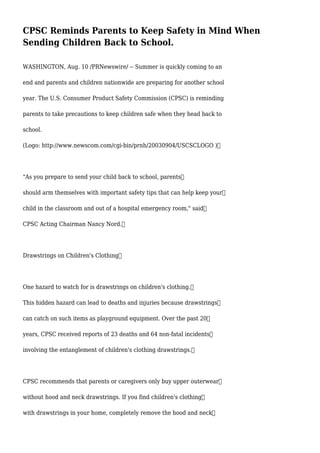
CPSC Reminds Parents to Keep Safety in Mind When Sending Children Back to School.
- 1. CPSC Reminds Parents to Keep Safety in Mind When Sending Children Back to School. WASHINGTON, Aug. 10 /PRNewswire/ -- Summer is quickly coming to an end and parents and children nationwide are preparing for another school year. The U.S. Consumer Product Safety Commission (CPSC) is reminding parents to take precautions to keep children safe when they head back to school. (Logo: http://www.newscom.com/cgi-bin/prnh/20030904/USCSCLOGO ) "As you prepare to send your child back to school, parents should arm themselves with important safety tips that can help keep your child in the classroom and out of a hospital emergency room," said CPSC Acting Chairman Nancy Nord. Drawstrings on Children's Clothing One hazard to watch for is drawstrings on children's clothing. This hidden hazard can lead to deaths and injuries because drawstrings can catch on such items as playground equipment. Over the past 20 years, CPSC received reports of 23 deaths and 64 non-fatal incidents involving the entanglement of children's clothing drawstrings. CPSC recommends that parents or caregivers only buy upper outerwear without hood and neck drawstrings. If you find children's clothing with drawstrings in your home, completely remove the hood and neck
- 2. drawstrings from all children's upper outerwear, including jackets and sweatshirts, size 2T through size 12. Wear the Right Helmet Rather than ride the bus, many children ride bikes, scooters and skateboards to school. To reduce the risk of serious head injury or death, children should wear a helmet -- and it is important to wear the appropriate helmet for your sport. About 800 people, approximately 180 children, died in bicycle-related incidents in a recent year. More than half of the 500,000 bicycle-related emergency room-treated injuries in 2005 involved children under the age of 15. Wearing a helmet can reduce the risk of a head injury by up to 85 percent. * Look for a label inside the bicycle helmet indicating it meets the CPSC standard. Other sport helmets, including those for skateboarders and football players, have labeling certifying compliance with other standards. * CPSC has a new publication entitled "Which Helmet for Which Activity." This brochure is a useful guide to parents and includes helmet information on sports kids play at every age level. Copies of this free publication are available at http://www.cpsc.gov/.
- 3. * Be aware of local laws pertaining to the use of pocket bikes and scooters, and do not ride on streets or in driveways. Many cities and communities have specific areas where scooters are permissible. Other communities prohibit entirely the riding of pocket bikes or motorized scooters. Here are additional tips from CPSC for Back-to-School Safety: Playgrounds: Each year, more than 200,000 children are taken to hospital emergency rooms due to playground-related injuries. Most injuries occur when a child falls onto the playground surface. * There should be a layer of safe, shock absorbing surface material, consisting of wood chips, mulch, sand, pea gravel, or mats made of safety-tested rubber or fiber material around playground equipment. * Make sure there is no exposed hardware to catch clothing and no free- hanging ropes attached to the equipment, which could cause strangulation. * For additional information on playground safety, see CPSC's Handbook for Public Playground Safety. Soccer Goals: Movable soccer goals can fall over and kill or injure children who climb on them or hang from the crossbar. Over the past 25 years, CPSC has reports of at least 28 deaths associated with soccer
- 4. goals. * Make sure soccer goals are securely anchored when in use. * Never allow children to climb on the soccer net or goal framework. * When not in use, anchor goals or chain them to a nearby fence post or sturdy framework. Art Supplies: CPSC has recalled a variety of art materials over the years due to sharp tools; accessible lead in crayons, chalk and paint; and other hazards. * Only buy art materials that contain the statement, "CONFORMS TO ASTM D- 4236." Many states have tax-free holidays prior to schools opening. Take advantage of this time to buy safe clothing and supplies for back to school. Parents should talk to school officials to make sure the school's equipment complies with all federal, state and local standards and requirements. In addition, CPSC urges parents and schools to check for recalled products or report a dangerous product or a product-related injury by calling CPSC's hotline at (800) 638-2772 or visit http://www.cpsc.gov/.
- 5. The U.S. Consumer Product Safety Commission is charged with protecting the public from unreasonable risks of serious injury or death from more than 15,000 types of consumer products under the agency's jurisdiction. Deaths, injuries and property damage from consumer product incidents cost the nation more than $700 billion annually. The CPSC is committed to protecting consumers and families from products that pose a fire, electrical, chemical, or mechanical hazard. The CPSC's work to ensure the safety of consumer products -- such as toys, cribs, power tools, cigarette lighters, and household chemicals -- contributed significantly to the 30 percent decline in the rate of deaths and injuries associated with consumer products over the past 30 years. To report a dangerous product or a product-related injury, call CPSC's hotline at (800) 638-2772 or CPSC's teletypewriter at (800) 638-8270 or visit CPSC's Web site at http://www.cpsc.gov/talk.html. Consumers can obtain this release and recall information at CPSC's Web site at http://www.cpsc.gov/. CONTACT: CPSC Media Contact: +1-301-504-7908